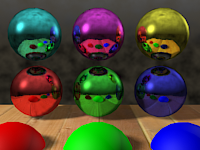The Raytrace material is an advanced surface-shading material. It supports the same kinds of diffuse surface shading that a standard material does. It can also create fully raytraced reflections and refractions. It also supports fog, color density, translucency, fluorescence, and other special effects.

Balls using raytrace material to reflect each other
The reflections and refractions Raytrace material generates are more accurate than those produced by the Reflect/Refract map. Rendering raytraced objects can be slower than using Reflect/Refract. On the other hand, Raytrace is optimized for rendering 3ds Max scenes. You can further optimize it for your scene by excluding specific objects from raytracing.
In some cases, the colors in the Basic Parameters rollout of Raytrace material behave differently from colors in standard materials. Standard material has a diffuse shading model that does an excellent job of rendering solid, nonreflective objects such as plastic, ceramic, and so on. In effect, this model applies color to the object. The color components in Raytrace material, on the other hand, attempt to model their physical counterparts in nature.
In Raytrace material, the surface reflects its Diffuse color component without specular reflection, while the Reflect color component controls the amount of specular reflection. These two material components are layered together. The results you see depend on the layering effect. For example, if the material is not transparent and completely reflective, no diffuse color is visible. If the material is not transparent and completely nonreflective, only the diffuse color is visible.
Raytrace material has a large user interface with a lot of controls. In general, if you are using Raytrace to create reflections
and refractions, the controls in the Basic Parameters rollout are the only ones you need to adjust. The Extended Parameters
rollout for Raytrace has controls for special effects. The Raytracer Controls rollout affects the raytracer itself. Use the
Raytracer Controls to turn the raytracer on or off, and to toggle other options. Use theRaytracer Global Parameters Rollout (Rendering  Raytrace Globals) to set options globally (for all Raytrace materials and maps in the scene), including recursion depth.
Raytrace Globals) to set options globally (for all Raytrace materials and maps in the scene), including recursion depth.
The Raytrace Basic Parameters rollout for a Raytrace material controls the material's shading, color components, reflectivity or refractivity, and bumps.
The Extended Parameters rollout for a Raytrace material controls the material's special effects, transparency properties, and advanced reflectivity.
The Raytracer Controls rollout for a Raytrace material controls affect the operation of the raytracer itself. It can help you improve rendering performance.
The controls on this dialog let you override the default acceleration values and specify your own requirements. Typically you don't need to use them, but if you are familiar with the requirements of your scene, they can help you optimize raytrace rendering for your specific needs and time constraints.
These dialogs let you specify which objects the raytracer will and won't see. This is a good optimization when you are working with complex scenes and all you really need is for an object to reflect itself or some other, simpler elements in the scene.
The Fast Adaptive Antialiaser dialog changes settings for the Raytrace material and maps Fast Adaptive antialiaser. You can use this dialog either globally, from the Raytracer Global Parameters rollout, or locally, from the Raytracer Controls rollout. When you locally change settings for an antialiaser, you don't affect the global settings for that antialiaser.
The Multiresolution Adaptive Antialiaser dialog changes settings for the Raytrace material and maps Multiresolution Adaptive antialiaser. You can use this dialog either globally, from the Raytracer Global Parameters rollout, or locally, from the Raytracer Controls rollout. When you locally change settings for an antialiaser, you don't affect the global settings for that antialiaser.